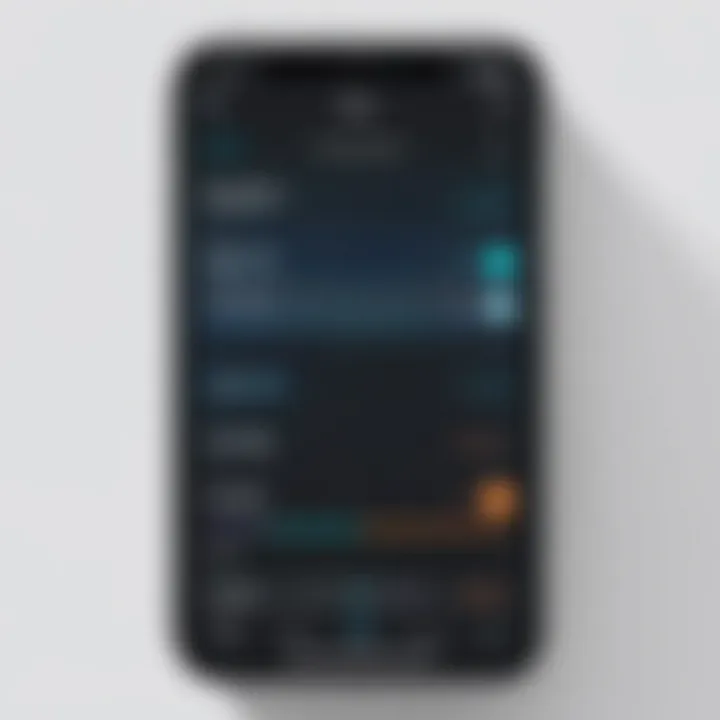Mastering the Alarm Feature on Your iPhone: A Complete Guide


Prelims
In an age where time management plays a crucial role in personal and professional life, mastering the alarm function on the iPhone becomes not just useful, but essential. This guide delves into the red the functionalities of setting alarms on your device, highlighting the ease and versatility it offers to users at any experience level.
Currently, iPhones are equipped with a multitude of alarm features that go beyond simply being sound-biting reminders. Users can tailor various elements such as alarm tones, repeat options, and even integration with other Apple devices. Aligning oneself with these features enhances not only scheduling and planning but also boosts overall productivity, offering an edge in a fast-paced digital world.
As we will see in this examination, the alarm functions are intuitive, but understanding their nuances can create a more seamless experience. Key points will cover how to set alarms, customize settings, and manage them effectively within the iOS environment, drawing comparisons when necessary. By the end of this comprehensive exploration, you will possess the insights required to utilize your iPhone's alarm features optimally.
Enabling notifications of different rhythms caters to diverse lifestyle needs; whether it's waking up, reminders for important meetings, or scheduled downtime, customizing alarms can profoundly impact our daily routine. Initialize this understanding and learn more about not just what can be accomplished but how to personalize alarms according to such diverse requirements.
Join me as we embark on this journey, because device efficiency emerges from familiarity with its features.
Product Overview
The iPhone serves as a modern consumer technology product that transcends basic communication needs, featuring an expansive list of functions that appeal to tech-savvy consumers.
Prelims to Apple iPhone's Alarm Feature
Almost all Apple iPhone models, from the original introduction to current developments, have recognized the significance of alarms, thus continually enhancing their functionalities. The seamless variables attached allows user to optimize the application according to personal preferences.
Key Features and Specifications
Including:
- Multifunctionality: Alarms not only serve as wake-up calls but also as timers, stopwatches, and sleep aids.
- Customization Options: Users have the ability to select unique tones for alarms, customize repeat parameters, and adjust volume settings.
- Synchronized Features: Users can synchronize alarms across devices that utilize iCloud, ensuring that alarms activate on multiple devices without user effort.
- Integration with Apple Health: Alarms can be set to complement health-related routines, such as sleep schedules.
As we progress through this guide, expect to learn more about these features and how they enhance the user experience, complementing daily routines effectively.
Testing the boundaries of this multi-faceted tool highlights not only convenience but versatility, aligning your iPhone with your lifestyle needs for a greater management of time and daily activities.
By understanding these features intimately, the road toward mastery of the iPhone’s alarms is paved.
Understanding the Alarm Feature
The alarm feature on the iPhone serves multiple purposes that go beyond mere alerting users at designated times. The in-built functionality is essential for personal time management, allowing users to schedule activities, wake up on time, and remind themselves of important tasks or appointments. Each aspect of this feature contributes to daily productivity, making it pivotal for people with busy or irregular schedules.
Instead of just setting a single alarm, users can schedule recurring reminders, allowing them to balance both personal and professional-life seamlessly. This customized flexibility is what makes the iPhone's alarm system highly advantageous. Users gain control over how they organize their time, increasing the likelihood that they meet deadlines or prioritize important tasks.
Availability of distinct alarm tones comes to be as another significant consideration. Missing an alarm can result in significantly negative consequences. Thus, having variety in sounds allows users to choose alerts that suit their preferences or the gravity of situations at hand. It further adds a personal touch to something as straightforward as setting a timer. Different tones enable differentiation between work alarms and personal ones, enhancing user experience.
Overall, understanding the alarm feature involves considering its functional capacity and aesthetic personalization. Educating oneself on all aspects results in enhanced utilization of this valuable tool. The subsequent sections will unfold how users can set up and customize alarms effectively.
Overview of Alarm Functionality
The alarm functionality on iPhones extends far beyond the basic ringing alert. Initially designed to signal specific times to remind users of engagements, it is today an integrated part of an individual’s lifestyle and time management.
• Alarm can be set for one-time events or scheduled regularly.
• Users can enable vibration alongside sounds to enhance awareness.
• The snooze function permits multiple brief delays, useful for users prone to derailing out of sleep.
Individual benefits of the alarm feature integrate into the daily workflow. Since users rely on mobile devices extensively, functionality tied to alarms yields attention whenever the need arises. Knowing how to manipulate this versatile feature is thus critical for optimizing usage.
Historical Context of Alarms on Mobile Devices
The evolution of alarms on mobile devices has grown parallel to the ubiquity of smartphones themselves. Early mobile devices that appeared had basic alarm functions, often lacking flexibility. They primarily served rudimentary alerting purposes. The arrival of smartphones marked a transformative journey, integrating utilities that few previously could imagine.
Mobile alarms became more sophisticated through additional capabilities, leading to greater user engagement and customization options. This innovation closely followed the development of applications, user interfaces, and overall compatibility within the devices.
Linking advanced features like snooze options and multiple sound selections became commonplace as mobile technology advances. Numerous studies imply realistic interaction with deadlines directly correlates to its perceived importance. Hence, the relevance of alarm functionalities only increases as a modern tool for effective time organization. It continues to fundamentally shape how tasks, reminders, and punctuality blend into lifestyles, ultimately proving instrumental to user efficiency today.
Navigating to the Clock App
Navigating to the Clock app is crucial for setting alarms on the iPhone. The Clock app serves as the central hub for all time-related functionalities, integrating alarms, timers, world clocks, and stopwatches in one place. Understanding how to access this app eases the entire alarm-setting process. Ensuring smooth navigation allows users to perform tasks efficiently, reduce frustration, and optimize their time management.
Accessing the App from Your Home Screen


To access the Clock app from your home screen, locate its icon. It resembles a standard clock face. Tapping this icon opens the app directly. If you frequently use the Clock app, consider placing it in an easily accessible location, like on the bottom dock of your screen or on an often-used page.
Here are a few quick tips:
- For Frequent Users: Move the app to a more accessible location for quicker access in the future.
- Organizing Apps: You can create folders for related apps in case you have multiple time management apps.
- App Updates: Regularly check your apps for any updates ensuring that you have the latest features and bug fixes.
The Smart folders feature on iOS sorts your apps by category and frequent usage, made it easier to find the Clock app without scrolling through all your applications extensively.
Using Siri to Open the Clock App
Siri provides an effortless alternative to open the Clock app. By employing simple voice commands, you can bypass manual navigation. This is particularly useful when your hands are occupied or when you need to act quickly. To utilize this capability, activate Siri by saying “Hey Siri” or by pressing the side button on your iPhone.
Once Siri is activated, simply state: “Open Clock.” Alternatively, you can say: “Set an alarm” and she will direct you to the alarm section immediately.
Some advantages of using Siri include the following:
- Hands-Free Convenience: Accessing the app without using your hands.
- Quick Actions: Enhances efficiency, especially travel-derived tasks.
- Direct Commands: Immediate access to the Clock app features with minimal delay, optimizing your workflow.
Setting an Alarm
Setting an alarm on an iPhone serves a critical role in daily routines. It helps users manage time effectively and promotes punctuality. In today’s fast-paced world, alarms go beyond mere notifications; they integrate into the daily structure of life for countless individuals. Whether waking up for work or setting reminders for important tasks, optimally configuring alarms can create a considerable impact.
Step-by-Step Instructions to Set an Alarm
Setting an alarm on your iPhone is straightforward. Follow these steps for a smooth experience:
- Open the Clock app from your home screen.
- Tap on the Alarm tab at the bottom.
- On the top right, select the + button to add an alarm.
- Turn the dial to the desired hour and minute.
- Save the alarm once all settings are configured.
This process simplifies parameters for users, ensuring they can set their alarms swiftly and efficiently. Alarms set thoughtfully help in establishing good habits and achieving goals.
Adjusting Alarm Settings
Selecting Time
Selecting time for an alarm is crucial. It allows users to specify the exact moment when they need a reminder. The key characteristic here is the ease of use created by the interface.
Having a precise time contributes to effectiveness; whether it’s getting up early in the morning or taking a break during the day, right timing is essential. Time selection may incorporate advanced features like gradual volume increase that enhances the waking experience. However, this could mean the possibility of accidentally setting the alarm at an unwanted time, so users must be attentive.
Choosing Repeat Options
Choosing repeat options allows an alarm to go off on certain days automatically. Many folks benefit from this feature, as repetitive tasks often characterize busy schedules.
Its key characteristic is flexibility. Users can set one-time alarms or daily, weekly, and weekday reminders. This features keeps all consistent daily routines in check. Yet, the downside is that it may cause confusion if a user has multiple alarms set to repeat at similar times; for instance, mixing weekend alarms with weekday schedules can cause one to miss one-off events.
Labeling Your Alarm
Labeling your alarm aids in identification and organization. It plays a significant role, particularly when managing multiple alarms. The unique feature here lies in adding specific context for each alarm, such as specifying 'Gym' for an early morning session or 'Bill Reminder' to avoid missed payments. This makes navigation simpler.
Users can enhance clarity through labeling, which proves beneficial when functioning in a crowded schedule. The only disadvantage might be failing to recall individual labels which could lead to misunderstanding alarms.
Alarms with labels provide a clearer direction in busy lives, prioritizing tasks and enhancing clarity.
Customizing Alarm Tones
Customizing alarm tones is a significant feature for iPhone users. It involves selecting sounds that resonate with individual preferences and needs. The alarm tone choice influences how we respond to our alarms. A favorable alarm tone can motivate us to wake up, while an unpleasant alarm might delay getting out of bed. Understanding how to customize these tones can add a personal touch to how users manage their time and routines.
Exploring Default Alarm Sounds
iPhones come with various default alarm sounds that users can explore. These are designed to cater to different preferences, providing options from soothing nature sounds to more energetic tones. For example, popular alarm sounds include "radar" and "silk," celebrated for their reach and varied rhythms. The soothing levels create a balance that is not overly jarring. Users can simply listen to various sounds and select the one they feel would best rouse them in the morning.
- Radar: A gradual build-up makes it a commonly chosen tone.
- Silk: Soft and melodious, provides a gentle waking experience.
These default tones can be easily accessed in the Clock app under the Alarm settings. Selecting a tone that aligns with personal preferences can dramatically affect waking experience.
Importing Custom Sounds


Beyond the default options, iPhones allow users to import custom sounds. This feature enhances personalization even further, giving access to a broader sound library. Users can utilize songs from their Apple Music library or download tones from the internet. Setting a unique sound can make waking up feel less monotonous.
To import custom sounds:
- Navigate to the iTunes Store or similar platforms where tones are available.
- Go through downloaded tones in your Library under Settings > Sounds & Haptics.
- Select the desired tone while setting the alarm.
Adding unique sounds might not only make waking up enjoyable but can also evoke nostalgia. Custom tones often define special moments or memories; users can choose sounds that inspire motivation or happiness. It's a small but impactful way to shape daily habits and routines, ultimately aiding in better time management.
"A good alarm sound can set a positive tone for the day ahead."
By taking the time to explore and customize alarm tones, iPhone users can enhance their overall experience with this versatile feature.
Managing Multiple Alarms
Managing multiple alarms on an iPhone is not just a convenience; it is often a necessity for those with busy schedules or varied responsibilities. The flexibility of the alarm feature allows users to create distinct alarms for different purposes, making time management more efficient. This means setting alarms for waking up, reminders for meetings, or notifications for medication. Each of these demands can be met by tailoring alarm settings, ensuring that life’s various rhythms are seamlessly supported by the device.
Setting multiple alarms can also enhance productivity. For example, having individual alarms for different tasks during the day helps reinforce a structured routine. It also allows users to have distinct sounds or labels for each alarm, which means a clearer association between the alarm sound and its intended task. Effectively managing your alarms can lead to better time management and reduced stress.
Creating Additional Alarms
To create additional alarms on your iPhone, follow these straightforward steps:
- Open the Clock app.
- Tap on the 'Alarm' tab at the bottom of the screen.
- You will see a list of any alarms you have already set. To add a new one, click the + sign in the top right corner.
- Set the desired time by scrolling the hour and minute selectors.
- Choose the days you want the alarm to repeat, if applicable.
- Optionally, label your alarm to reflect its purpose, such as “Morning Workout.”
- Finally, select an alarm sound and press Save.
With these steps, you can create as many alarms as necessary, allowing for a dynamic scheduling system that adapts to daily requirements. It's also worth noting that each alarm can be individually customized, enhancing its utility.
Editing and Deleting Alarms
Editing and deleting alarms is equally essential for staying organized. If a particular alarm is no longer needed, it can easily be deleted. This is especially practical in preventing alarm overload, which may create confusion and noise. To edit or delete alarms, do the following:
Editing an Alarm:
- Access the 'Alarm' tab in the Clock app.
- Tap the Edit button in the top left corner to enter edit mode.
- Select the alarm you wish to change. Adjust the time, repeat setting, label, or sound as needed.
- Save the changes by tapping Save again.
Deleting an Alarm:
- Still in edit mode, press the red minus sign next to the alarm you wish to remove.
- Tap Delete to confirm the removal of the alarm.
Regularly updating your alarms helps maintain an orderly environment, fostering enhanced concentration and efficiency.
This approach not only streamlines alarms but also allows individuals to keep up with their evolving schedules and responsibilities. Moving forward, these steps can make managing alarms seamless, providing the clarity and organization needed for today's fast-paced environment.
Using the Alarm Function with Other Apple Devices
Using alarms on your iPhone can vastly improve your daily routine, especially when integrated with other Apple devices. This comprehensive section focuses on how alarms can function seamlessly across various items in the Apple ecosystem. Enhanced connectivity and synchronization between devices help ensure your alarms are always accessible, regardless of location.
Integrating with Apple Watch
The integration of the alarm function with the Apple Watch represents a seamless facet of Apple's approach to device synergy. Setting an alarm on your iPhone also reflects automatically on your Apple Watch. This dual functionality means you can easily change or disable alarms through either device.
As benefits of integration, your wrist offers vibration alerts, which is discreet and effective. Consider moments when you may not want to disturb others—like in a meeting or a quiet space. The watch vibrates as a reminder without raising volume alerts that affect those around you. The use of your iPhone to manage these functions provides a user-friendly interface, where simply tapping your watch can suffice for quick changes.
"Apple's integration of alarms across devices strengthens the user's connection to time management and organization."
Such efficient interactions translate to less missed appointments or snoozed alarms. Users who require reminders when exercising or during another activity praise the hands-free capabilities that bind both devices.
Synchronization with HomePod
When incorporating HomePod into your alarm management, the experience blends technology with comfort. Setting alarms through your HomePod allows for voice-command capabilities, which can streamline your interactions with Apple’s ecosystem. Users can create or modify alarms just by asking Siri on the HomePod, providing convenience in scenarios where using an iPhone might not be practical.
This synchronization means alarms blend into daily activities more naturally. For instance, you can not only set a morning alarm based on your specifications but also ask HomePod to play a selected music or playlist edition at your desired waking time.
Utilizing these features advances the paper applications of alarm settings while enhancing usability, making your daily wake-ups a more enjoyable experience.
When managing alarms with HomePod, it’s essential to ensure that all devices are synced properly under the same Apple ID. This will eliminate any inconsistencies across devices, offering a smooth alarm management experience.


With the advancements in Apple’s technology, syncing alarms and utilizing other devices enhances functionality and satisfies users requiring effective timekeeping solutions. Leveraging these systems together empowers individuals uniquely, optimizing how we wake up, stay alert, and manage our time.
Troubleshooting Common Alarm Issues
In a fast-paced world, relying on alarms for punctuality is a key aspect for many. However, alarms may not always work as intended due to various issues. This section highlights common problems encountered while using alarms on an iPhone, along with suggested solutions. Understanding how to troubleshoot these problems can greatly enhance your experience with the alarm feature. Everyone benefits from a functioning alarm, ensuring they are alerted according to their needs.
Alarm Not Sounding
One of the frequent issues users face is that the alarm does not sound even when set correctly. There can be multiple reasons behind this problem. The most common cause might stem from the sound settings. If the volume is muted or set too low, the alarm may not be heard. Here are some steps to consider:
- Check the ringer switch on the side of your iPhone. Ensure it is in the 'ring' position.
- Go to Settings > Sounds & Haptics. Adjust the Ringer and Alerts Volume. It should be appropriately high for alarms to be audible.
- Review the alarm tone; if it’s a very soft sound, it might not grab your attention.
Another possible reason could stem from Do Not Disturb mode. When activated, this can silence alarms depending on the settings. Users must ensure that the alarm settings permit notifications when Do Not Disturb is turned on. Checking this includes:
- Navigating to Settings then Do Not Disturb. Adjust the options for Allow Calls From or consider enabling method for alarms to pass through.
If all settings appear correct, restarting the device might rectify any temporary glitches that could interfere with the alarm feature. This also acts as a reset strategy for your iPhone’s hardware and software.
Misconfigured Settings
Misconfigured settings are another common root cause of failed alarms. Users may accidentally modify important alarm parameters without realizing it. It is crucial to hash out which settings could be causing the issue. Consider the following:
- Ensure you have selected the right alarm time. Users sometimes set for PM instead of AM.
- Along with timing issues, check repeat settings. A common mistake is to select daily or specific repetitions that can lead to a misunderstanding about when the alarm will go off.
- The option for vibrate only should also be checked. If this is selected without sound, the alarm will go off silently.
Understanding these configurations can avoid misunderstandings. Performing a quick review of these points can save the hassle of sleeping through an important event or meeting.
Always double-check your alarm settings before sleep. A minor adjustment could save you from a late start.
By addressing the frequent pitfalls around alarm functionality, iPhone users can streamline the alarm-setting process. In the next section, we look at advanced features to enhance the experience further.
Exploring Advanced Features
Exploring advanced features associated with alarms on your iPhone holds significance for users who seek to optimize their time management and device utility. Knowing how to leverage tools such as timers, stopwatches, and sleep timers can enhance daily productivity, provide a better user experience, and capture varying user needs. Each advanced feature in the alarm suite adds functionality allowing for more customization and precision in approaching daily tasks or routines.
Setting Timers and Stopwatches
The timer and stopwatch functions set themselves apart from traditional alarms by focusing on precision and immediate tasks rather than scheduled wake times. Timers enable users to allocate specific durations for activities. This functionality aids in time management, especially for mundane tasks such as cooking or exercising, where knowing how long a task should take is essential. With the iPhone interface, setting a timer is direct: just state the desired time and adhere to pre-defined intervals.
Setting a stopwatch facilitates activities that require exact timing, perfect for processes measured in seconds rather than minutes. Sporting events or timed examinations often see usage of stopwatches for accurate tracking. To begin, a user presses ‘Start’ and pauses functionally allows for flexible resets.
Key Benefits of Using Timers and Stopwatches:
- Efficient organization of daily tasks
- Enhanced focus on activities due to time constraints
- Valuable for measuring performance in workouts or competitions
Sleep Timer Functionality
Sleep timers relate to controlling the time for audio or video playback on devices before they turn off. IPhones utilize sleep timers primarily within their Music app and other playback apps. This functions greatly for users wishing to fall asleep while listening to music or an audiobook. By setting a sleep timer, an individual can ensure that audio playback only persists for a designated duration, thus preventing ongoing playback during sleep, which can turn frustrating.
Users appreciate having this functionality because it conserves battery energy and enhances relaxation during rest. Easily, one can navigate to the Clock app and select the timer options or control it directly from the media playback screen features.
Advantages of Using Sleep Timers:
- Promotes healthy sleep habits
- Saves battery life by conserving energy in playback mode
- Simple setup encourages user interaction with audio features
Achieving consistency in managing your time through advanced features like sleep timers and stopwatches, your iPhone transforms into a more indispensable productivity tool rather than just an alarm clock. These features can redefine daily routines and empower users in their time-managing endeavor.
The End
Setting an alarm on the iPhone is not just a matter of waking up or reminding yourself about important events. It encompasses various features and functionalities that allow users to tailor their experience according to their specific needs. This is significant in today’s fast-paced world, where being organized can contribute greatly to personal efficiency and time management.
Summary of Key Features
When you explore the alarm function on your iPhone, there are several key features to consider:
- Customizable alarms: You can set alarms for different times, customize their labels, and adjust repeat options to fit your routines.
- Alarm tones: The ability to choose from a variety of default tones or import custom sounds allows personalization.
- Multiple alarms: Creating, editing, or deleting many alarms without limits helps in better management of tasks and schedules.
- Synchronization with other Apple devices: If you own an Apple Watch or HomePod, integrating these devices enhances convenience, ensuring you never miss an alarm, regardless of the device you are using.
- Advanced features: Settings for timers and sleep features promote effective time management, whether you are looking to focus on tasks or extend your restful periods.
Understanding these features enables you to leverage the alarm function fully and appreciate its roll in enhancing everyday organization and efficiency.
Final Thoughts on Alarm Efficiency
Furthermore, the comprehensive nature of these capabilities creates a seamless integration into one's daily routines. Whether waking up early, timing productivity periods, or establishing relaxing bedtimes, a well-configured alarm system offers noticeable benefits. Therefore, understanding and implementing these features is crucial in today’s demanding landscapes, where clarity and discipline in scheduling can positively affect productivity levels and overall mood.
“A well-set alarm is not just about waking up, it’s about providing structure in a world that often lacks it.”



